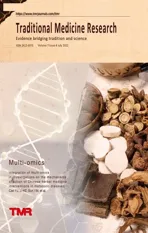Biologically active components for cosmeceutical use extracted from Chaetomorpha aerea
2022-06-28HareshKalasariyaLeonelPereiraNikunjPatel
Haresh S.Kalasariya,Leonel Pereira,Nikunj B.Patel
1Microbiology Department,Sankalchand Patel University,Visnagar 384315,India.2University of Coimbra,MARE -Marine and Environmental Sciences Centre,Department of Life Sciences,Coimbra 3000-456,Portugal.
Abstract Background:The utilization of seaweed-based biologically active components in cosmeceutical formulations has been extensively rising due to skin health-promoting effects.Seaweeds have varieties of biologically active components and possess potential benefits in skincare products.Methods:Hence,the present study was done to characterize the bioactive constituents of green seaweed Chaetomorpha aerea by using the gas chromatography coupled with high-resolution mass spectrometry technique in ethanolic and methanolic extracts for presenting its cosmetic potential. Results: In analysis, a total of twenty-one different components were found in both the extracts.Their cosmetic potentials have been studied based on previous research studies.In addition, we characterized 9-octadecenoic acid [Z]-, phenylmethyl ester which belongs to benzyloxycarbonyls class.This compound exhibits promising applications in the cosmeceutical sector.This compound has a target peak percentage area (16.64%) with a retention time (39.1 min) in methanolic extract. Conclusion: The incorporation of seaweed-based bioactive components in cosmetics has been extensively growing due to its skin health-promoting effects.
Keywords:GC-HRMS;octadecenoic acid;chemical characterization;cosmeceutical applications
Background
Seaweeds are literall y sea vegetables (like carrots, and other land vegetables), and have been used for centuries as food by people such as the Chinese (with an ancestral tradition of using herbal medicine),Japanese, Egyptians, Romans, Scots, Irish, Icelanders, Scandinavians,Germans and the Indians of Latin America, who used their potential healing power of various diseases in the form of traditional medicines[1].Currently, the acceptance of the therapeutic potential of these bioactive substances, extracted from algae, in addition to the simple ingestion of the algae itself, is a generally accepted fact, and its extracts are used in the production of medicines, preparation of cosmetics, and therapeutic baths [2–6].
To meet the demand of consumers, the cosmeceutical industries are moving towards the unstoppable use of synthetic cosmetics and ingredients.Kerdudo et al.[7]reported harmful effects of widely used parabens on the skin, its physiological functions as well as being responsible to cause skin cancer, malignant melanoma, DNA modifications,and damage as proved in human sperm cells[8,9].Due to the ineffectiveness, toxicities, and harmful properties of synthetic ingredients, customers have switched their preferences and attribute toward sustainable natural cosmetic formulations [10].Hence, the continually developing market for skincare products and continuous search for alternative sustainable ingredients led to the development of natural formulations [11].In some parts of the world, there is the utility of seaweeds as a possible opportunity for formulating cosmeceutical products natural [6, 12].
Seaweed similarly known as marine macroalgae are eukaryotic,multicellular,photosynthetic ubiquitously distributed organisms along the seacoasts.Seaweeds are normally inhabiting the intertidal, tidal,and sub-tidal regions of coastal areas [13].Seaweeds are mainly classified into three main types, namely brown algae, red algae, and green algae belonging to the Phaeophyceae class, Rhodophyta and Chlorophyta phyla,respectively.In which,green and red algae belong to the Plantae kingdom,whereas brown algae belong to the Chromista kingdom [13, 14].Marine macroalgae are a plentiful source of chemically diversified biological active components.It contains ten-time greater diversified phycocompounds than terrestrial plants[15].Broad applications of marine macroalgae are based on valuable bioactive compounds and potential bioactivities.The utilization of macroalgae in cosmeceutical applications is according to their valuable bioactive constituents, such as polysaccharides, proteins,pigments, lipids, fatty acids, amino acids, phenolic compounds,pigments, minerals, and vitamins [16, 17].
Seaweeds are prominent for various kinds of fatty acids such as glycolipids, triglycerides, sterols, and phospholipids which have been reported high in seaweed.Seaweed-derived fatty acids have antiallergic and antiinflammation activity as well as a skin protector role.Dawczynski et al.[18] and Rhimou et al.[19] studied effective bacterial growth inhibition from methanolic extract ofCeramium virgatum(asCeramium rubrum) (Rhodophyta) againstEscherichia coli,Enterococcus faecalis, andStaphylococcus aureus.Vasconcelos et al.[20]found the antioxidant activity of methanolic extract fromAlsidium triquetrum(asBryothamniontriquetrum) (Rhodophyta) by 2,2-diphenyl-1-picrylhydrazyl assay and 2,2’-azino-bis(3-ethylbenzothiazoline-6-sulfonic acid) assay in vitro.Besides, it may serve as softening compound that makes skin safe by preventing water loss[21].Pimentel et al.[22],Mišurcová et al.[23],and Tapiero et al.[24] suggested the responsible role of polyunsaturated fatty acids(omega-3,omega-6)for skin nutrition and for maintaining skin health.These fatty acids are important regulators of several cellular reactions as well as good health mediators.Bonnet [25], Bialek, et al.[26],Rabasco and Rodríguez[27],Zielińska and Nowak[28],suggested the significant importance of fatty acids in healing effects, can be used in creams, emulsions, face masks, lipsticks, bath liquid soap, nail polishes, etc.Mainly mixtures of triglycerides of saturated and unsaturated fatty acids are generally used as an ingredient in cosmetic formulations.
Ryu et al.[29] reported antiaging and antioxidant activity was reported in methanolic extract ofCorallina pilulifera(Rhodophyta) by reducing the expression of gelatinase and by inhibition of free radical oxygen species in human dermal fibroblast and human fibrosarcoma(HT-1080).Moreover, it plays a chief role in overcoming excessive dryness of the skin in addition to its use beneficial for skin and hair.Browning [30] have been demonstrated the accessorial role of long-chain n-3 polyunsaturated fatty acids in an anti-inflammatory effect.Long-chain fatty acids can contribute moisturizing and anti-inflammatory actions likewise medium-chain fatty acids protect against inflammation and tumor factors.In addition, short-chain fatty acids can provide anti-inflammatory effects and initiate immune response [31].Furthermore, fatty acids proved to be crucial in overcoming excessive dryness of the skin as well as their use is beneficial for skin and hair[32].
Several previous research studies characterized and found the presence of 9-octadecenoic acid [Z]-, phenylmethyl ester through gas chromatography-mass spectrometry (GC-MS) in different organisms.In plants, Farag et al.[33] reported the presence of the said volatile compound in roots, stems, and seeds ofSalvadora persica(toothbrush tree) (Tracheophyta).Moni et al.[34] characterized this compound in ethyl acetate fraction ofSyzygium fruticosum(Tracheophyta)by GC-MS analysis at a retention time (RT) of 16.29 min with a peak area of 0.54% whereas Al-Saman et al.[35] found this volatile compound in methanolic extract ofArthrospira platensis(asSpirulina platensis)(Cyanobacteria) by GC-MS analysis at RT 29.81 min with 0.69% peak area.Alagammal et al.[36] characterized the same compound from ethanolic extract ofPolygala rosmarinifolia(Seneca snakewood)(Tracheophyta) by GC-MS analysis at RT 35.07 min and 4.72% peak area.In addition, Elsayed et al.[37] found 9-octadecenoic acid (Z) in the hydrolysate of the fermentedPhoenix dactylifera(date palm fronds)(Tracheophyta) byTrichodermasp.(Ascomycota) PWN6 in GC-MS analysis at RT 25.144 min with 44.42% peak area.
The present study aims to characterize bioactive molecules in green macroalgaChaetomorpha aerea(C.aerea) (formerlyChaetomorpha crassa) [38] by using high-resolution gas chromatography combined with high-resolution mass spectrometry (GC-HRMS) analysis.
Methods
Collection of the marine alga C.aerea
Sample collection was done in sterile plastic bags containing marine water from the western coast of Gujarat, Beyt Dwarka sea coast(22°28'43.5″N 69°08'08.8″E), India (Figure 1), and transported to the laboratory for further analysis.C.aerea(asChaetomorpha crassa)(Chlorophyta)(Figure 2)was collected from the intertidal zone during low tide conditions.Then the sample material was washed thoroughly to remove extra marine debris, epiphytes, and salts in running tap water.Lastly,the sample was rinsed with deionized water and allowed to complete shed dried for five to seven days, until the moisture was completely removed.By using an electric grinder, this material was ground into a fine powder and kept in air-tight containers at room temperature until further analysis.The identification of the collected sample was done by taking the help of Dr.Nilesh H.Joshi,at Fisheries Department, Junagadh Agriculture University, Okha, Gujarat, India[38, 39].
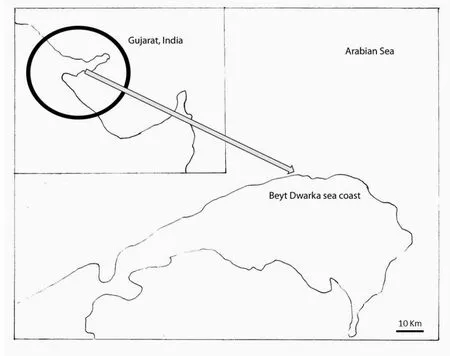
Figure 1 Location of sample collection site (22°28′43.5″N 69°08′08.8″E)
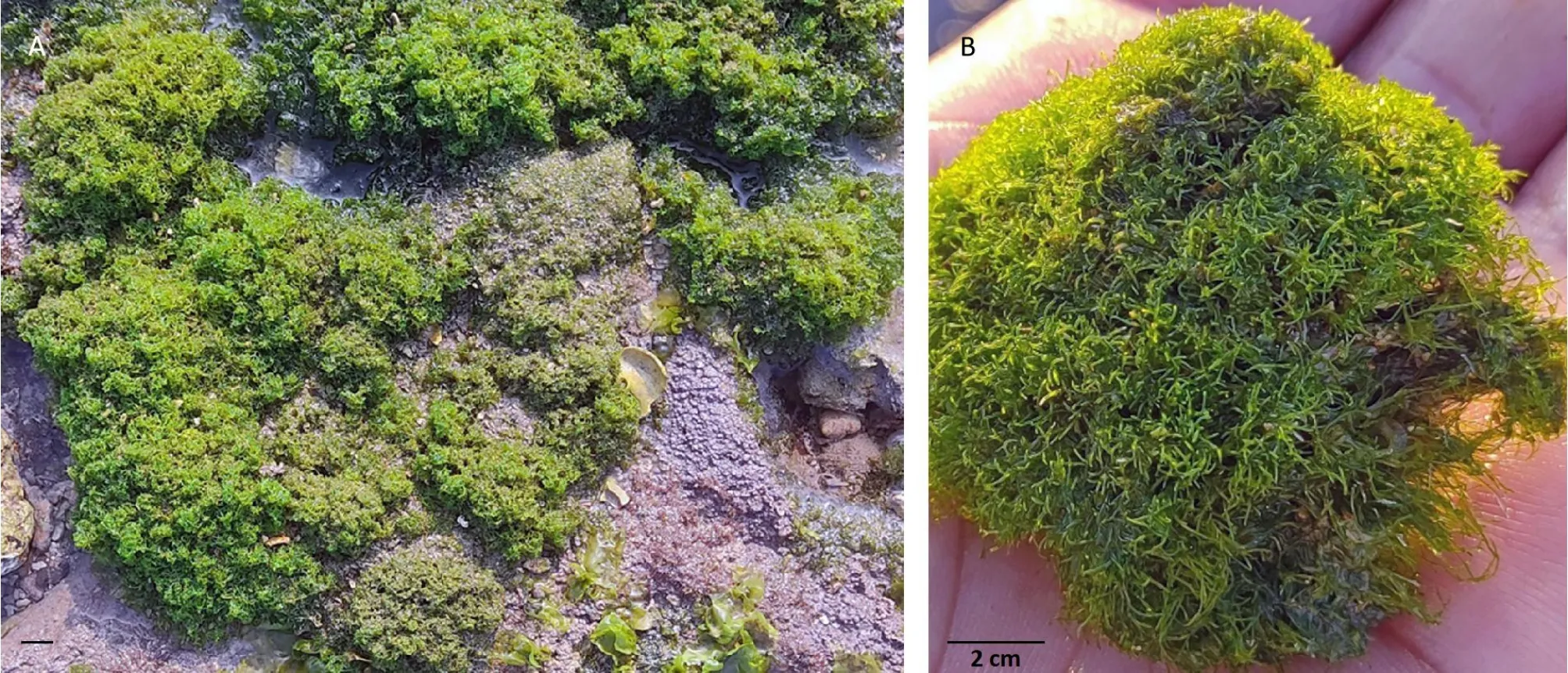
Figure 2(A) On shore view, and (B) specimens detail of Chaetomorpha aerea (Chlorophyta)
Characterization of bioactive components
Extraction ofC.aereawas done in ethanol (Sigma Aldrich, Bengaluru,India) solvent (80%) by adding 500 g shed dried powder by continuous hot percolation using the Soxhlet method.It was about 24 h,then filtered and kept in a hot air oven(RDHO 80,REMI,Bengaluru,India) at 40 °C for 24 h to evaporate the solvent from it.The extract obtained was concentrated to dryness under reduced pressure (150 Mbar) at 20 °C using a rotary evaporator (Sigma Scientific, Chennai,India).The final residue was kept in airtight containers and stored in a freezer at-20 °C (Esquire Biotech, Chennai, India).
In GC-MS characterization, the sample was injected into an EB-5 column in a gas chromatography instrument (model: JMS-T100GCV)for chromatographic separation.A gas chromatogram was obtained and the mass spectrum of the unknown phycocompounds was compared with the spectrum of the known components stored in the National Institute of Standard and Technology library (version 2005).Gas chromatography specifications include carrier gas: helium; flow rate:1 mL/min;column oven temperature:50–250°C;injection mode:10 °C/min.Mass spectrometry specifications include model: AccuTof Mass from Jeol; ionization voltage: 70 eV; ion source temperature:250 °C; mass range: 50–600 mass units.
Characterization of fatty acid derivatives
Extraction ofC.aereawas done with methanol solvent in the proportion of 1:10 (w/v) in a flask for 72 h.This mixture was filtered using Whatman No.1 paper in a separate sterile deionized container.This procedure was repeated twice with the obtained residues using fresh methanol (Sigma Aldrich, Bengaluru, India).After collection of supernatants, the excess solvent was removed by rotary evaporator(Sigma Scientific, Chennai, India) and preserved in refrigerated condition for further characterization.
The GC-MS characterization analysis was accomplished using a gas chromatograph model JMS-T100GCV and combination with a mass detector AccuTof Mass from Jeol.For analysis, the sample was introduced into an HP-5 column.The specifications include ion source temperature: 250 °C; interface temperature: 250 °C; mass range:50–600 mass units and helium flow rate: 1 mL/min.The ionization voltage was 70 eV.The samples were injected in split mode at 1:10.A gas chromatogram was come by, and the mass spectrum of each compound was interpreted with the spectrum of the available compounds stored in the National Institute of Standard and Technology library (version 2005).The name of the compound,molecular formula,and molecular weight of compounds was retrieved.By comparison of the average peak area to the total area, the relative percentage amounts of the compound were calculated.
Results
India is one of the 12 mega biodiversity nations in the world and has the longest coastline about 8,100 km.Gujarat, one of the Indian states possesses a longer than 1,600 km coastline which is varied in topography, geomorphology, coastal processes, and river discharge into the Arabian Sea.More than 844 seaweed species were reported along the Indian sea coast, whereas more than 198 seaweed species were reported along the coast of Gujarat.Green algaC.aereaspecies is especially found in winter and summer seasons (found for long-duration than other algae species) in temperatures from 16 to 25°C, in salinity from 9‰ to 13‰ and in upper to mid-intertidal pools on the coast.It is found attached to sandy or muddy parts of the benthic area as well as forming groups on the water surface.This environment is suitably found on the Beyt Dwarka sea coast (one of the well-known and big coastal sites of the western coast of Gujarat).Hence, this study was carried out by focusing on green macroalgaC.aereabecause this alga is highly found along the western coast of Gujarat.Marine macroalgae contain good amounts of bioactive compounds than terrestrial organisms that can be utilized in various applications, including medicine, cosmetics, foods, pharmaceutical,agriculture, etc.Their growth rate is higher than the plants and other food resources.It can be collected naturally but presently is increasingly cultivated.This makes them special interested and attention for study other organisms.In addition, they do not require extra fertilizer as well as in vitro conditions to cultivate in bulk amounts.They have significant environmental appeal because they do not require freshwater nor much land [40–42].
Characterization of bioactive constituents by GC-MS analysis
The GC-HRMS analysis of the ethanolic extract and methanolic extract showed a total of twenty-one compounds that were identified based on the RT, percentage peak area, molecular formula, and molecular weight.A gas chromatogram with the different peaks of both extracts is illustrated in Figure 3.A total of 6 different bioactive compounds were detected in the ethanolic extract ofC.aerea(Table 1).Among the identified phycocomponents,compound No.3 is found to be the major compound, since it revealed the largest peak percentage area(48.89%), with 37.03 min of RT.The gas chromatogram of each detected phycocompounds in the ethanolic extract is reported in Figure 4, whereas the mass spectrum of each detected phycocompounds is presented in Figure 5.Skin cosmetic benefits of each of these phycocompounds are presented in Table 2 [43–48].
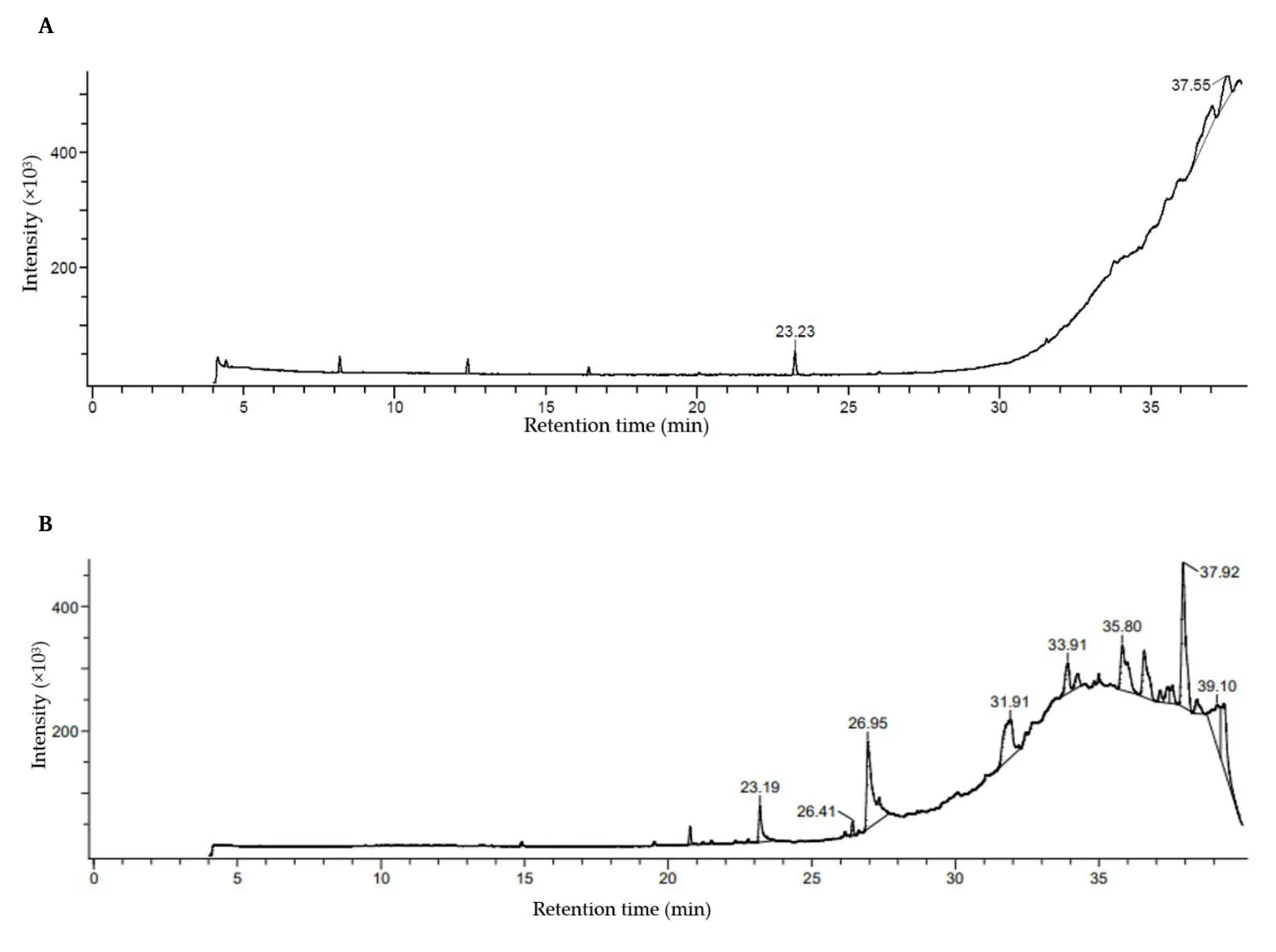
Figure 3 Chromatogram obtained by GC-HRMS analysis of (A) ethanolic extract of Chaetomorpha aerea and (B) methanolic extract of Chaetomorpha aerea.Comments for: (A) Split1: 10;80-1M-6-200-2M-8-275-5M-5-280-EB5; AccuTOF GCv: 40.00.650.00.(B) Split1:10;80-1M-6-200-3M-8-275-5M-5-280-; AccuTOF GCv: 35.00.650.00.GC-HRMS, gas chromatography combined with high-resolution mass spectrometry.
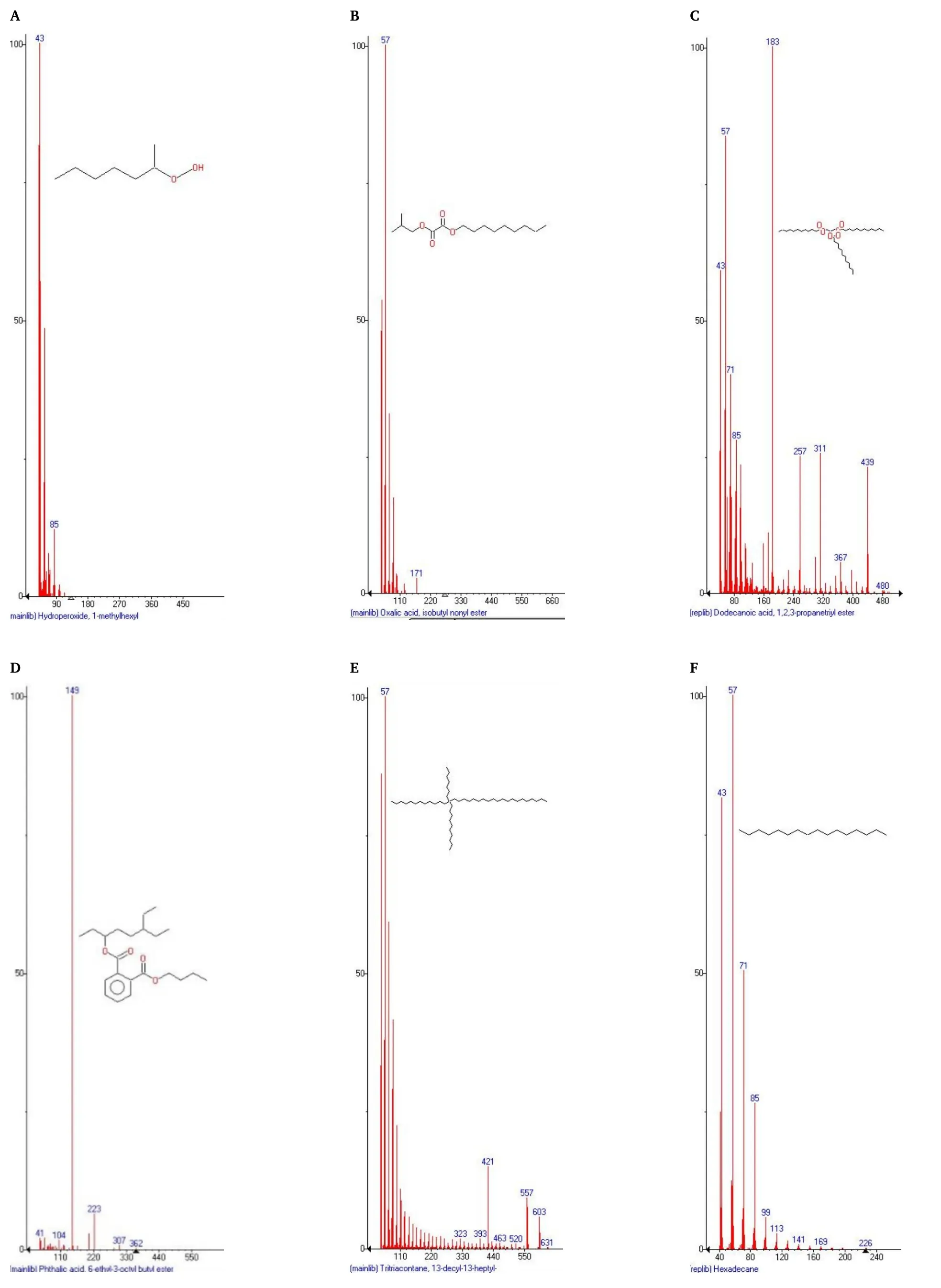
Figure 4 Gas chromatogram of the different bioactive the compound in ethanolic extract.(A)Hydroperoxide, 1-methylhexyl;(B)oxalic acid,isobutyl nonyl ester; (C) dodecanoic acid,1,2,3-propanetriyl ester; (D) phthalic acid, 6-ethyl-3-octyl butyl ester; (E) tritriacontane,13-decyl-13-heptyl-; (F) hexadecane.A higher value represents the largest peak whereas a lower value represents the smallest peaks (horizontal axis:hits, vertical axis:relative abundance).

Table 1 Details of phycochemicals identified through GC-MS analysis of an ethanolic extract from Chaetomorpha aerea
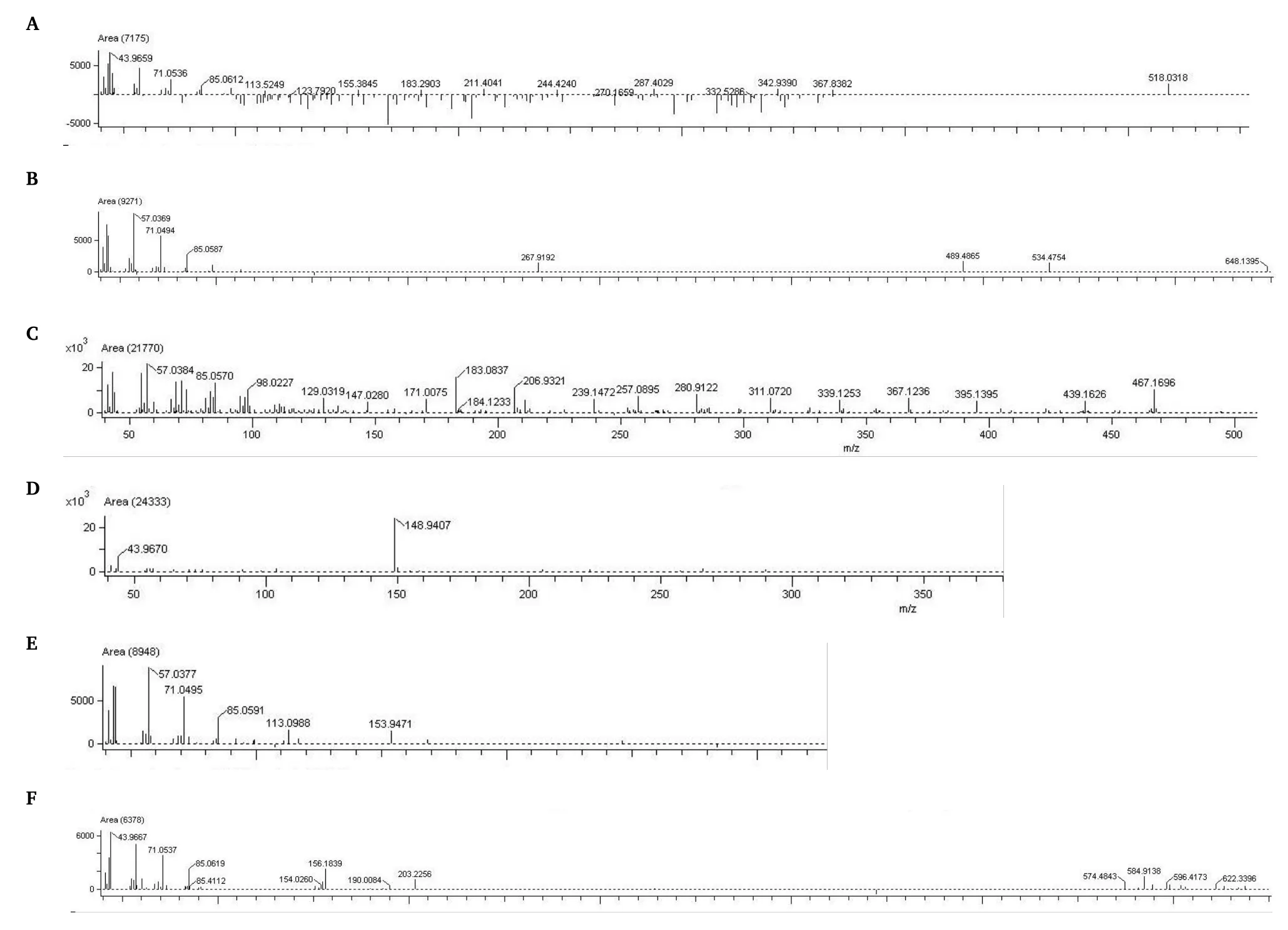
Figure 5 Mass spectrum of bioactive components in ethanolic extract.(A)Hydroperoxide,1-methylhexyl;(B)oxalic acid,isobutyl nonyl ester;(C)dodecanoic acid,1,2,3-propanetriyl ester; (D) phthalic acid, 6-ethyl-3-octyl butyl ester; (E)tritriacontane, 13-decyl-13-heptyl-; (F) hexadecane(horizontal axis:m/z value, vertical axis:intensity (×103)).

Table 2 Skin cosmetic benefits of phycocompounds found in ethanolic extract
In the methanolic extract ofC.aerea, a total of fifteen different peaks were detected and identified for different fatty acids from the methanolic extract.The gas chromatogram and mass spectrum of each detected phycocompound in the methanolic extract are reported in Figure 6 and Figure 7.Among identified compounds, 9-octadecenoic acid [Z]-, phenylmethyl ester is found to be the top constituent because it has the largest peak % area, with 39.1 min of RT among others, whereas oxirane, tetradecyl- reported the lowest peak % area,with 26.41 min of RT.In Table 3, compounds No.1, 2, and 4 are long-chain fatty acids that belong to superclass lipid and lipid-like molecules.Other lipid-like molecules,such as compounds No.5 and 9,were found to be linoleic acids and derivatives, whereas compound 7,called campesterol acetate, was an ergosterol derivative.Compounds No.8 and 12 were found to be stigmastane derivatives (steroid derivatives) belonging to the superclass lipid and lipid-like molecules.Moreover, compounds No.13, 14, and 15 were found to be fatty acid methyl esters (with fatty acyls).In addition, compound No.11 was reported to be hydroxy secosteroid, a compound which is known as calcidiol (or calcifediol), a lipid-like molecule.Apart from fatty acid derivative compounds, compound No.3 belonged to organ heterocyclic compounds, whereas compound No.6 was an unsaturated aliphatic hydrocarbon belonging to superclass hydrocarbons.Lastly, compound No.10 was found to be a hydrocarbon derivative or an aldehyde derivative.The chemical structures of all the obtained compounds are represented in Supplementary Figure S1.
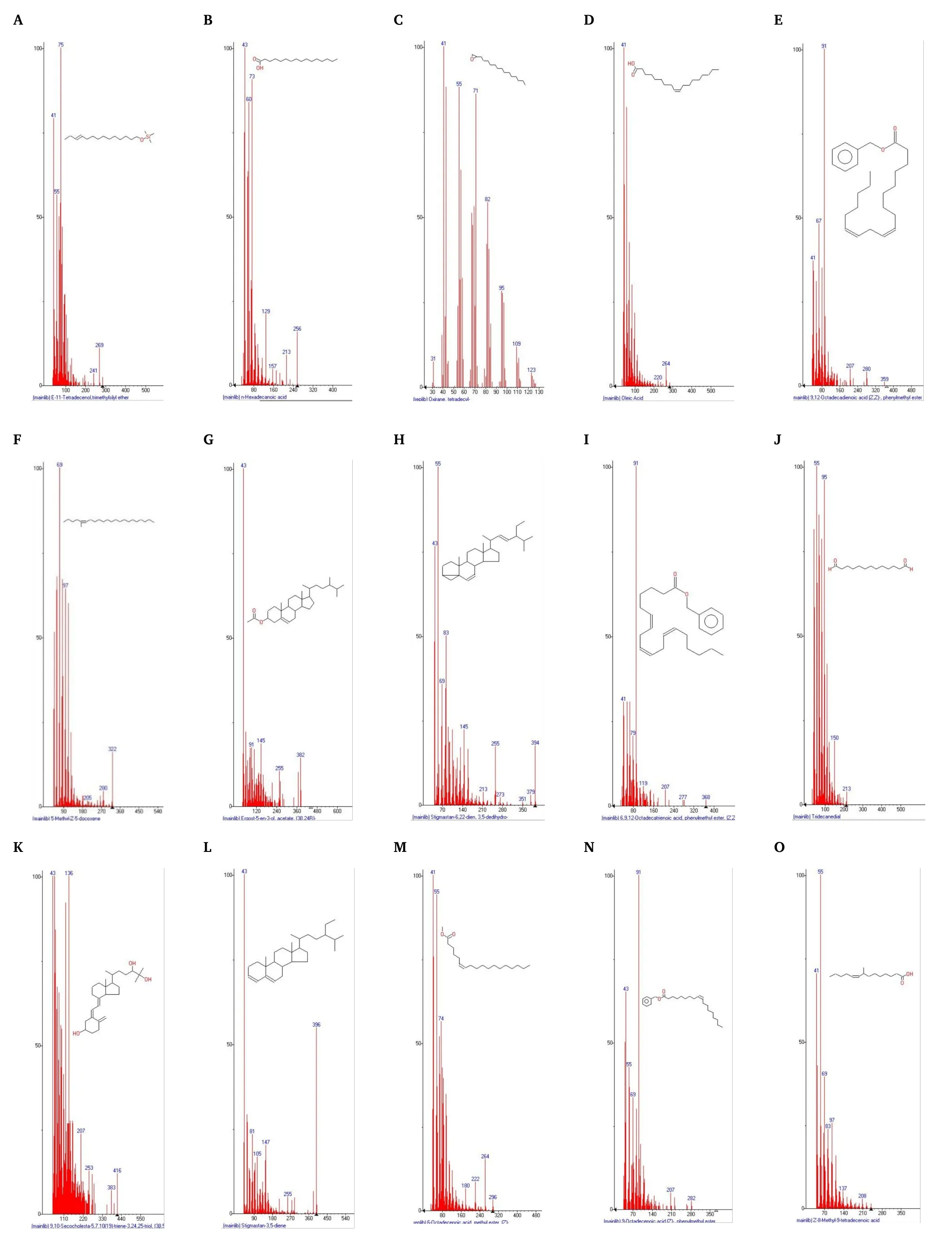
Figure 6 Gas chromatogram of different bioactive compound in methanolic extract.(A) E-11-Tetradecenol, trimethylsilyl ether; (B)n-hexadecanoic acid;(C)oxirane,tetradecyl-;(D)oleic acid;(E)9,12-octadecadienoic acid[Z]-,phenylmethyl ester;(F)5-methyl-Z-5-docosene;(G)ergost-5-en-3-ol, acetate, [3β,24R]-; (H) stigmastan-6,22-dien, 3,5-dedihydro-; (I) 6,9,12-octadecatrienoic acid, phenylmethyl ester, [Z,Z,Z]-; (J)tridecanedial; (K) 9,10-secocholesta-5,7,10[19]-triene-3,24,25-triol, [3β,5Z,7E]-; (L) stigmastan-3,5-diene; (M) 6-octadecenoic acid, methyl ester,[Z]-; (N) 9-octadecenoic acid [Z]-, phenylmethyl ester; (O) Z-8-methyl-9-tetradecenoic acid.A higher value represents the largest peak whereas a lower value represents the smallest peaks (horizontal axis: hits,vertical axis: relative abundance).
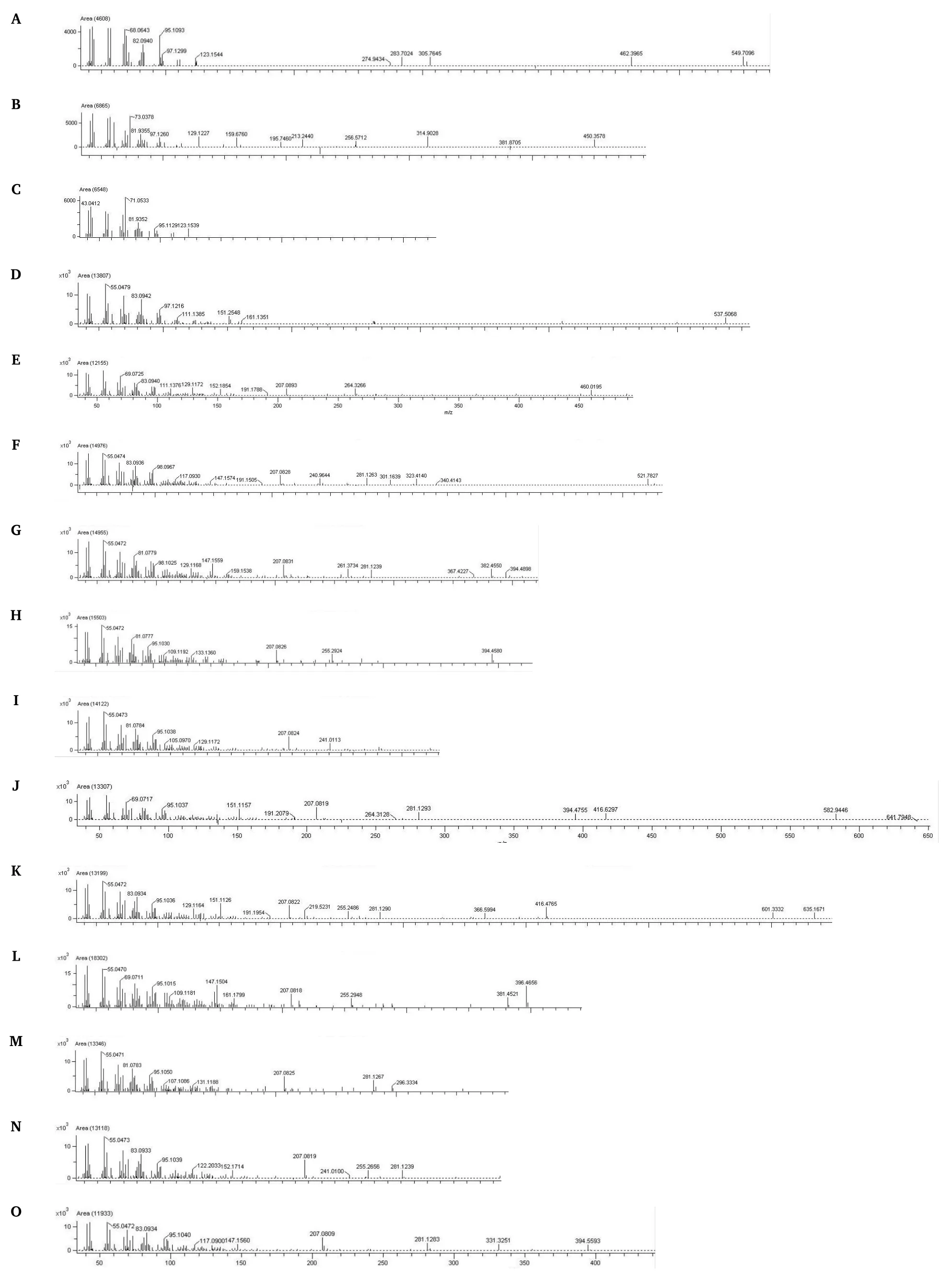
Figure 7 Mass Spectrum of bioactive components in methanolic extract.(A) E-11-Tetradecenol, trimethylsilyl ether; (B) n-hexadecanoic acid;(C) oxirane, tetradecyl-; (D) oleic acid; (E) 9,12-octadecadienoic acid [Z]-, phenylmethyl ester; (F) 5-methyl-Z-5-docosene; (G) ergost-5-en-3-ol,acetate, [3β,24R]-; (H) stigmastan-6,22-dien, 3,5-dedihydro-; (I) 6,9,12-octadecatrienoic acid, phenylmethyl ester, [Z,Z,Z]-; (J) tridecanedial; (K)9,10-secocholesta-5,7,10[19]-triene-3,24,25-triol, [3β,5Z,7E]-; (L) stigmastan-3,5-diene; (M) 6-octadecenoic acid, methyl ester, [Z]-; (N)9-octadecenoic acid[Z]-, phenylmethyl ester; (O) Z-8-methyl-9-tetradecenoic acid(horizontal axis:m/z value, vertical axis:intensity (×103)).
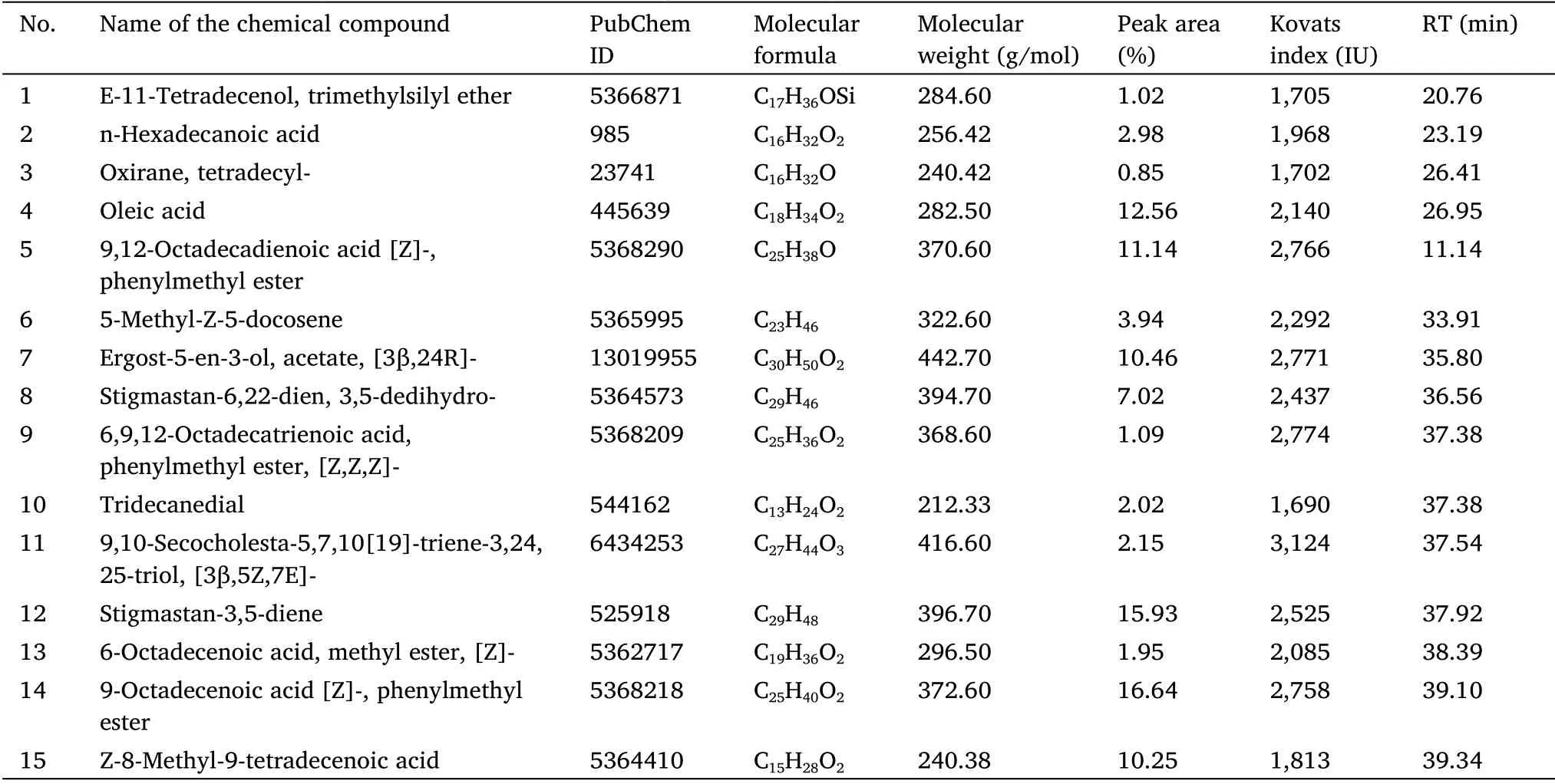
Table 3 Detail of phycochemicals identified through GC-MS analysis of the methanolic extract from Chaetomorpha aerea
Fatty acids and derivatives play an important role in maintaining skin health as well as its tone.Antibacterial and anti-inflammatory benefits of fatty acids are suggested by Cui et al.[49].Moreover, fatty acids have some other skin benefits, such as moisturization and lubrication of the skin [50].Fatty acids are a beneficial player in barrier functions.These acids are of different types,such as long-chain fatty acids, medium-chain fatty acids, and short-chain fatty acids.Long-chain fatty acids become needful in moisturization and protection against harmful substances.They also play an important role in the metabolic regulation of skin cells.Likewise, medium-chain fatty acids work as anti-inflammatory and antitumor agents.In addition, short-chain fatty acids can protect against inflammation and initiate an immune response[51].
9-Octadecenoic acid [Z]-,phenylmethyl ester
In GC-MS characterization analysis, the identification of 9-octadecenoic acid [Z]-, phenylmethyl ester, also known as benzyl oleate, was carried out according to its RT, percentage peak area,molecular formula, and molecular weight.Among the identified compounds, 9-octadecenoic acid [Z]-, phenylmethyl ester was found to be the major compound that attained the largest peak area(16.64%)with an RT(39.1 min).This compound is a fatty acid methyl ester that formed due to condensation between 9-octadecenoic acid and phenyl methanol.In the structure of this compound, 9-octadecenoic acid,known as oleic acid, is classified as a monounsaturated omega-9 fatty acid, abbreviated with a lipid number of 18:1 cis-9.
9-Octadecenoic acid [Z]-, phenylmethyl ester was found to be part of fatty acid methyl esters (with fatty acyls).It is known as oleic acid benzyl ester or benzyl (9Z)-9-octadecenoate.In this molecule, benzyl is the substituent or fragment possessing the chemical structure C6H5CH2
-or a benzene ring attached to a CH2group,whereas oleate is a negatively charged long straight chain of monounsaturated fatty acid and the conjugate base of oleic acid.It provides skincare benefits,such as antiaging, and prevents skin dryness.Oleic acid (a long-chain saturated fatty acid)and its esters are fatty acids required for soothing benefits and they are used in cosmetic products or topic formulations.Mao-Qiang et al.[52] reported its role in physiological structures of the skin and pathologies, by demonstrating its effects on skin barrier functions such as the production of eicosanoid, skin repair, and by improving permeability.Goreja [53] and Akihisa et al.[54]demonstrated anti-inflammatory and anti-tumor upgrading effects of oleic acid, which reports for 85%–90% of fatty acids.Free fatty acids,specifically monounsaturated free fatty acids, such as oleic acid, may damage skin layers and increase skin permeation for other compounds that are found in plant oils[55].Clinical considerations of skin barrier function were measured by correlating the concentration of oleic acid concerning triglycerides.Pereira et al.[56], Carrillo et al.[57], and Shin et al.[58] found the application of oleic acid in an anti-inflammatory activity and the activation process of immune cells.It presents many skin benefits such as anticancer, autoimmune, and anti-inflammatory roles, and it takes part in wound healing activity.
Moni et al.[59] studied toxicological properties of 9-octadecenoic acid [Z]-, phenylmethyl ester by Insilco tools, and found non-Ames toxic, non-carcinogenic, category III in acute oral toxicity with 50%lethal dose values >500 mg/kg and <5,000 mg/kg.On the other side, this compound would not violet more than one of the base parameters in Lipinski’s rule of five that reported it as orally active.This rule demonstrates the extent of drugs absorption and bioavailability upon molecular weight, hydrogen bond acceptors,hydrogen bond donors, and LogP-value [60].Besides, the antiviral activity of 9-octadecenoic acid [Z]-, phenylmethyl ester was found[61].In addition, there are other benefits of similar compounds reported in previous studies such as Akpuaka et al.[62] reported antioxidant and anticancer activity of 9-octadecenoic acid [Z]-,methyl ester.Rahuman et al.[63] reported the antimicrobial effect of 9-octadecenoic acid whereas antibacterial and anticancer activity was revealed by 9,12-octadecadienoic acid [Z,Z]-, methyl ester [64, 65].Moreover, 9-octadecenoic acid [Z]- was noted useful for anticancer,antibacterial,antifungal,lipoxygenase inhibition,and lubrication[66].In another finding, Kanjana et al.[67] suggested the benefits of 9-octadecenoic acid [E]- such as anti-inflammatory, anti-neurogenic,antiprotozoal, antifungal, antibacterial, and immunosuppressant.
Discussion
The current study focused on the characterization of bioactive compounds fromC.aereaby GC-HRMS.The current findings revealed thatC.aereais a valuable source of lipid-like molecules, fatty acid methyl esters, and other actives.GC-MS characterization ofC.aerearevealed the presence of 9-octadecenoic acid [Z]-, phenylmethyl ester compound in major amount among others with highest percentage peak area.This compound as well as other detected compounds played an essential role in the formation and protection of skin barriers, anti-inflammatory, soothing, moisturizing, antimicrobial,and photoprotective effects.It is also foremost for the build-out and maintenance of the physical well-being of the skin.Moreover, there is growing interest and potential for seaweed-derived molecules in cosmetic formulation due to skin benefits and applications.
Conclusion
The GC-MS analysis characterized the presence of different bioactive components in methanolic and ethanolic extract ofC.aerea.This compound has great value in cosmeceutical applications.Hence, this characterization analysis is further helpful for its extraction and cosmetic evaluation for leading it to market use.Besides, marine macroalgae and derived bioactive molecules demonstrated potential to be incorporated in cosmeceutical applications with many skin benefits which can be used as a substitute for synthetic cosmetics.Aside from that, phycocompounds from marine algae are more productive to be used in cosmeceuticals as they are less harmful as well as natural to the skin structure in contrast to synthetic compounds.
杂志排行
Traditional Medicine Research的其它文章
- Integration of multi-omics in investigations on the mechanisms of action of Chinese herbal medicine interventions in metabolic diseases
- Active compounds in RenShenJian decoction ameliorate insulin resistance in vitro
- Quality evaluation of Pinelliae Rhizoma using network pharmacology and multicomponent quantitative analysis
- Inhibition of rat prostate smooth muscle contractility by extracts of Costus speciosus(crepe ginger)
- Advances in traditional Chinese medicine for respiratory disease therapy in 2021
- Toxicological advances of traditional medicine in 2021
